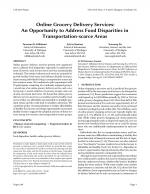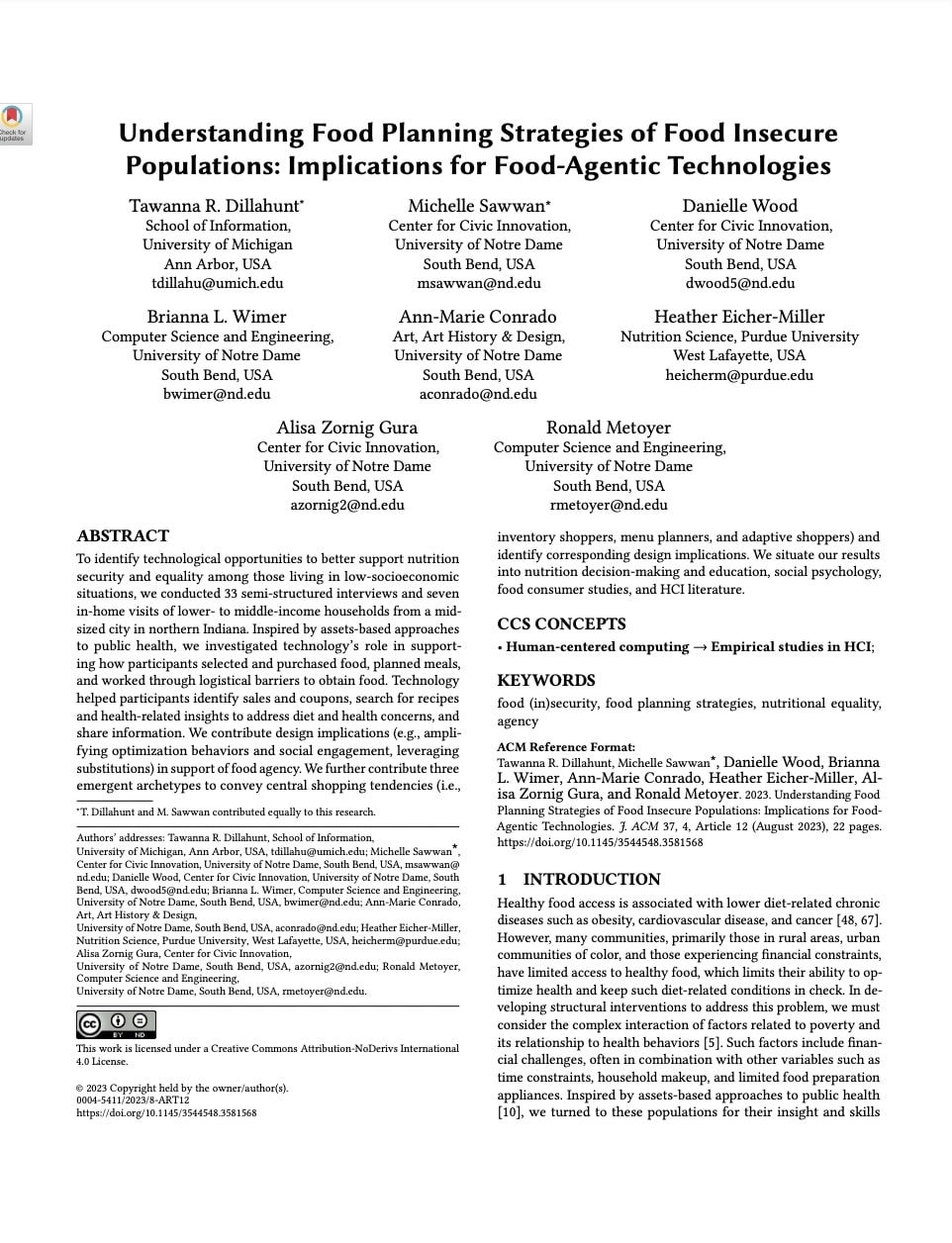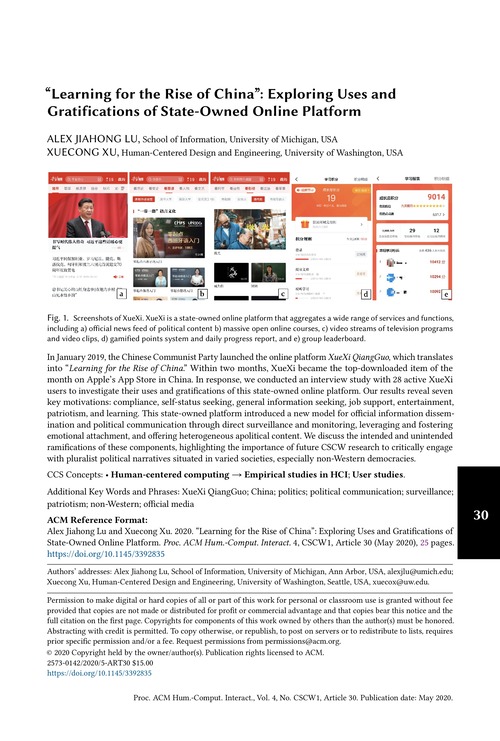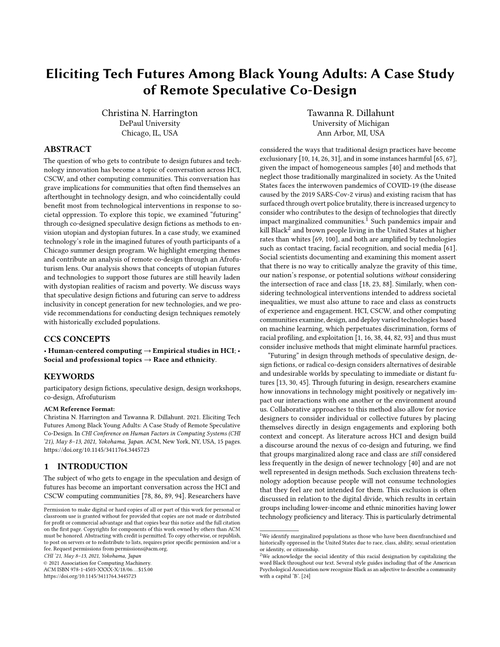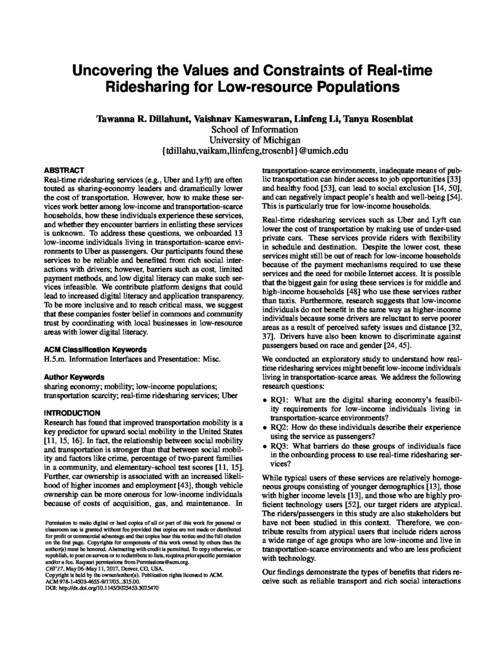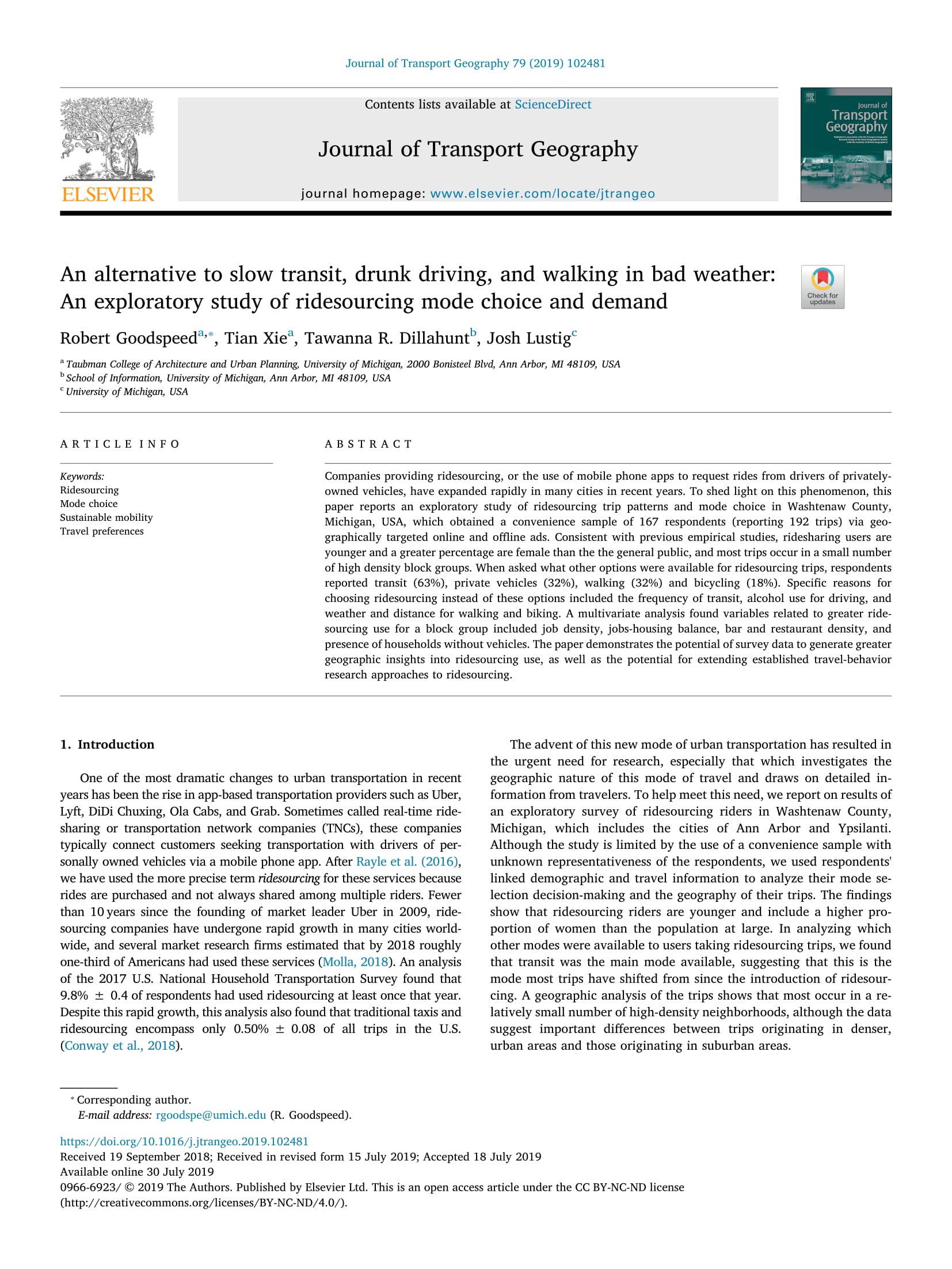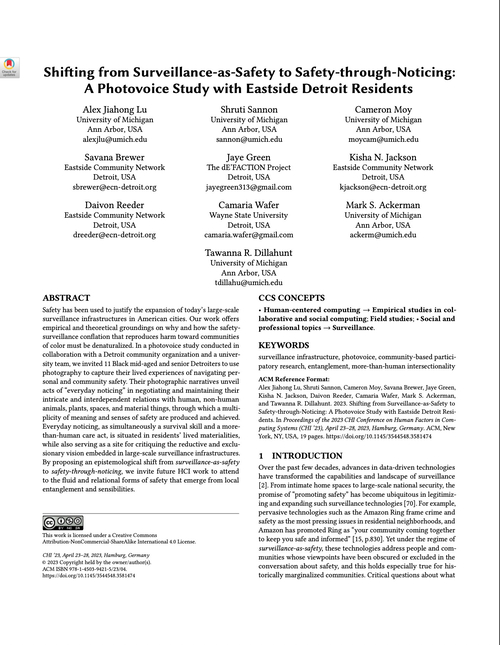Related work
-
Watched, but Moving: Platformization of Beauty Work and Its Gendered Mechanisms of Control
Anwar, I. A., Pal, J., and Hui, J. (2021)
| In Proc. of the ACM'21 Conference on Human Compurt Interaction, CSCW3 | Women gig workers face unique challenges in on-demand platforms as gendered aspects of class, caste, and labor participation intersect with moments of control experienced on the job. Through in-depth interviews with 19 beauty workers on on-demand home service platforms, we explore how the platformization of informal beauty work in India has ruptured dominant socio-cultural structures of control that have traditionally shaped women’s mobility and access to work. This paper maps the ways in which women beauty gig workers experience and are impacted by algorithmic and bureaucratic management practices prevalent in the gig economy, in the context of home service platforms in Bangalore. We find that platform control impacts lives in myriad ways, beyond the conditions of work. Women workers negotiate their identities and sense of agency through the visibility afforded by platform control mechanisms. Yet, despite these subversions, being on a platform does not fundamentally change the socio-cultural logic that restricts women’s lives in India. These mechanisms work to entrench power asymmetries between customers and workers, as well as maintain them between the platform and the worker. -
Online Grocery Delivery Services: An Opportunity to Address Food Disparities in Transportation-scarce Areas
*Best Paper* | Dillahunt, T. R., Simioni, S., and Xu, X. (2019)
| In Proc. of the CHI'19 Conference on Human Factors in Computing Systems | Online grocery delivery services present new opportunities to address food disparities, especially in underserved areas. However, such services have not been systematically evaluated. This study evaluates such services’ potential to provide healthy-food access and infuence healthy-food purchases among individuals living in transportation-scarce and low-resource areas. We conducted a pilot experiment with 20 participants consisting of a randomly assigned group’s 1-month use of an online grocery delivery service, and a control group’s 1-month collection of grocery receipts, and a set of semi-structured interviews. We found that online grocery delivery services (a) serve as a feasible model to healthy-food access if they are afordable and amenable to multiple payment forms and (b) could lead to healthier selections. We contribute policy recommendations to bolster afordability of healthy-food access and design opportunities to promote healthy foods to support the adoption and use of these services among low-resource and transportation-scarce groups. Health insurance shoppers attempting to find the best health insurance plan for their needs may benefit from reviews of plans left by other consumers; however, these reviews must be fairly detailed in order to be valuable. We posit that an appeal to empathy may motivate consumers to leave more detailed, and thus more valuable, reviews about health insurance plans for future insurance purchasers. -
Understanding Food Planning Strategies of Food Insecure Populations: Implications for Food-Agentic Technologies
Dillahunt, T.R., Sawwan, M., Wood, D., Wimer, B.L., Conrado, A.M., Miller, H.E., Gura, A.Z., and Metoyer, R. (2023)
Understanding Food Planning Strategies of Food Insecure Populations: Implications for Food-Agentic Technologies Dillahunt, T.R., Sawwan, M., Wood, D., Wimer, B.L., Conrado, A.M., Miller, H.E., Gura, A.Z., and Metoyer, R. (2023) | In Proc. of the CHI'23 Conference on Human Factors in Computing Systems | To identify technological opportunities to better support nutrition security and equality among those living in low-socioeconomic situations, we conducted 33 semi-structured interviews and seven in-home visits of lower- to middle-income households from a midsized city in northern Indiana. Inspired by assets-based approaches to public health, we investigated technology’s role in supporting how participants selected and purchased food, planned meals, and worked through logistical barriers to obtain food. Technology helped and health-related insights to address diet and health concerns, and share information. We contribute design implications (e.g., amplifying optimization behaviors and social engagement, leveraging substitutions) in support of food agency. We further contribute three emergent archetypes to convey central shopping tendencies (i.e.,inventory shoppers, menu planners, and adaptive shoppers) and identify corresponding design implications. We situate our results into nutrition decision-making and education, social psychology, food consumer studies, and HCI literature. -
Learning for the Rise of China’: Exploring Uses and Gratifications of State-Owned Online Platform
Lu, A. and Xu, X. (2020)
| In Proc. of ACM'20 Conference on Human Computer Interaction CSCW 1 | In January 2019, the Chinese Communist Party launched the online platform XueXi QiangGuo, which translates into “Learning for the Rise of China.” Within two months, XueXi became the top-downloaded item of the month on Apple’s App Store in China. In response, we conducted an interview study with 28 active XueXi users to investigate their uses and gratifications of this state-owned online platform. Our results reveal seven key motivations: compliance, self-status seeking, general information seeking, job support, entertainment, patriotism, and learning. This state-owned platform introduced a new model for official information dissemination and political communication through direct surveillance and monitoring, leveraging and fostering emotional attachment, and offering heterogeneous apolitical content. We discuss the intended and unintended ramifications of these components, highlighting the importance of future CSCW research to critically engage with pluralist political narratives situated in varied societies, especially non-Western democracies. -
Eliciting Tech Futures Among Black Young Adults: A Case Study of Remote Speculative Co-Design
Harrington, C. N. and Dillahunt, T. R. (2021)
| In Proc. of CHI'21 Conference on Human Factors in Computing Systems | The question of who gets to contribute to design futures and technology innovation has become a topic of conversation across HCI, CSCW, and other computing communities. This conversation has grave implications for communities that often fnd themselves an afterthought in technology design, and who coincidentally could beneft most from technological interventions in response to societal oppression. To explore this topic, we examined “futuring” through co-designed speculative design fctions as methods to envision utopian and dystopian futures. In a case study, we examined technology’s role in the imagined futures of youth participants of a Chicago summer design program. We highlight emerging themes and contribute an analysis of remote co-design through an Afrofuturism lens. Our analysis shows that concepts of utopian futures and technologies to support those futures are still heavily laden with dystopian realities of racism and poverty. We discuss ways that speculative design fctions and futuring can serve to address inclusivity in concept generation for new technologies, and we provide recommendations for conducting design techniques remotely with historically excluded populations. -
Coding Bias in the Use of Behavior Management Technologies: Uncovering Socio-technical Consequences of Data-driven Surveillance in Classrooms
Lu, A. J., Marcu, G., Ackerman, M. S., and Dillahunt, T. R. (2021)
*Honorable Mention* | In Proc. of the CHI '21 Conference on Human Factors in Computing Systems | Digital educational technologies have been employed in classrooms to collect students’ behavioral data in the hope of supporting teachers in identifying and correcting undesirable behaviors, which raises the concern of heightened surveillance in classrooms. We present a qualitative study of 20 K-8 teachers to understand their experiences and practices of using ClassDojo, a data-driven classroom behavior management intervention. Our analysis reveals a series of unintended socio-technical effects resulting from the use of ClassDojo in practice. In particular, the use of ClassDojo runs the risk of measuring, codifying, and simplifying the nuanced psycho-social factors that may drive children’s behavior and performance, thereby serving as a “Band-Aid” for deeper issues. We discuss how this process could perpetuate existing inequality and bias in education. With the goals of spurring future design and mitigating these unintended effects, we take on the reflexive-interventionist approach and propose three considerations for designing and using future educational technologies: 1) provide context, 2) expose bias, and 3) challenge and reimagine what is normal -
Uncovering the Values and Constraints of Real-time Ridesharing for Low-resource Populations
Dillahunt, T. R., Kameswaran, V., Li, L., and Rosenblat, T. (2017)
| In Proc. of CHI '17 Conference on Human Factors in Computing Systems | Real-time ridesharing services (e.g., Uber and Lyft) are often touted as sharing-economy leaders and dramatically lower the cost of transportation. However, how to make these services work better among low-income and transportation-scarce households, how these individuals experience these services, and whether they encounter barriers in enlisting these services is unknown. To address these questions, we onboarded 13 low-income individuals living in transportation-scarce environments to Uber as passengers. Our participants found these services to be reliable and benefited from rich social interactions with drivers; however, barriers such as cost, limited payment methods, and low digital literacy can make such services infeasible. We contribute platform designs that could lead to increased digital literacy and application transparency. To be more inclusive and to reach critical mass, we suggest that these companies foster belief in commons and community trust by coordinating with local businesses in low-resource areas with lower digital literacy. -
Support for Social and Cultural Capital Development in Real-time Ridesharing Services
Kameswaran, V., Cameron, L., and Dillahunt, T. R. (2018)
| In Proc. of the CHI '18 Conference on Human Factors in Computing Systems | Today’s transportation systems and technologies have the potential to transform the ways individuals acquire resources from their social networks and environments. However, it is unclear what types of resources can be acquired and how technology could support these efforts. We address this gap by investigating these questions in the domain of real-time ridesharing systems. We present insights from two qualitative studies: (1) a set of semi-structured interviews with 13 Uber drivers and (2) a set of semi-structured interviews with 13 Uber riders. Our results show that both drivers and riders acquired and benefited from informational, emotional and instrumental resources, as well as cultural exchanges via interactions with each other and with online platforms. We argue that these interactions could support the development of social and cultural capital. We discuss our findings in the context of labor and contribute design implications for in-car social and cultural experiences and for the ways technologies such as GPS and location-based services can support the additional emotional, social, and cultural labor that drivers provide to their riders. -
An alternative to slow transit, drunk driving, and walking in bad weather: An exploratory study of resourcing mode choice and demand
Goodspeed, R., Xie, T., Dillahunt, T. R., Lustig, J. (2019)
| In Proc. of Transport Geography | Companies providing ridesourcing, or the use of mobile phone apps to request rides from drivers of privatelyowned vehicles, have expanded rapidly in many cities in recent years. To shed light on this phenomenon, this paper reports an exploratory study of ridesourcing trip patterns and mode choice in Washtenaw County, Michigan, USA, which obtained a convenience sample of 167 respondents (reporting 192 trips) via geographically targeted online and offline ads. Consistent with previous empirical studies, ridesharing users are younger and a greater percentage are female than the the general public, and most trips occur in a small number of high density block groups. When asked what other options were available for ridesourcing trips, respondents reported transit (63%), private vehicles (32%), walking (32%) and bicycling (18%). Specific reasons for choosing ridesourcing instead of these options included the frequency of transit, alcohol use for driving, and weather and distance for walking and biking. A multivariate analysis found variables related to greater ridesourcing use for a block group included job density, jobs-housing balance, bar and restaurant density, and presence of households without vehicles. The paper demonstrates the potential of survey data to generate greater geographic insights into ridesourcing use, as well as the potential for extending established travel-behavior research approaches to ridesourcing -
Shifting from Surveillance-as-Safety to Safety-through-Noticing: A Photovoice Study with Eastside Detroit Residents
Lu, A.J., Sannon, S., Moy, C., Brewer, S., Green, J., Jackson, K.N., Reeder, D., Wafer, C., Ackerman, M.S, and Dillahunt, T.R. (2023)
| In Proc. CHI'23. Conference on Human Factors Computing Systems | Safety has been used to justify the expansion of today’s large-scale surveillance infrastructures in American cities. Our work ofers empirical and theoretical groundings on why and how the safetysurveillance confation that reproduces harm toward communities of color must be denaturalized. In a photovoice study conducted in collaboration with a Detroit community organization and a university team, we invited 11 Black mid-aged and senior Detroiters to use photography to capture their lived experiences of navigating personal and community safety. Their photographic narratives unveil acts of “everyday noticing” in negotiating and maintaining their intricate and interdependent relations with human, non-human animals, plants, spaces, and material things, through which a multiplicity of meaning and senses of safety are produced and achieved. Everyday noticing, as simultaneously a survival skill and a morethan-human care act, is situated in residents’ lived materialities, while also serving as a site for critiquing the reductive and exclusionary vision embedded in large-scale surveillance infrastructures. By proposing an epistemological shift from surveillance-as-safety to safety-through-noticing, we invite future HCI work to attend to the fuid and relational forms of safety that emerge from local entanglement and sensibilities.

